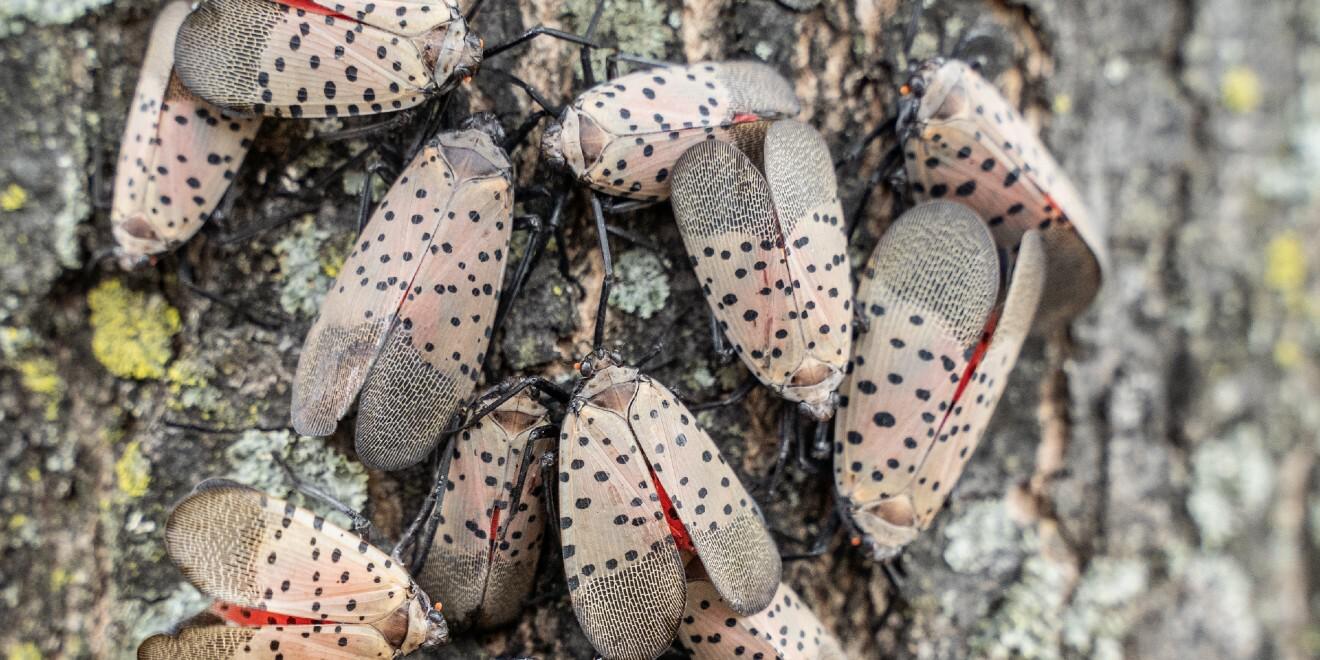What Are Spotted Lanternflies?
Posted by Mosquito Squad
February 26, 2024
Get to Know the Invasive Spotted Lanternfly
Spotted lanternflies, or Lycorma delicatula, are winged treehopper insects that have been damaging plants and trees in the United States since they arrived in 2014 from China. They hop far but aren’t strong fliers, so their spread relies heavily on attaching to traveling vehicles.
Whether you moved to or traveled through an infected region, or if your region is the next hotspot, it’s important to know the pest you’re dealing with.
So, what are spotted lanternflies? And what should you do if you “spot” one?
What Do Spotted Lanternflies Look Like?
You can help keep your yard safe by learning spotted lantern fly identification.
Here’s how spotted lanternflies look across the nymph and adult stages:
Nymph stage
Premature spotted lanternflies come out between June and July. They’re up to an inch long and have black bodies with white spots. As the nymph ages, it develops red blocks on the body. Commonly you’ll see this stage through July and September.
Adult stage
Adult spotted lanternflies are commonly seen from July to December. They’re one inch long by half an inch wide, with closed wings. They have yellow abdomens with black bars. Their upper wings are gray to brown with black spots and speckled gray at the tip. The lower wings are red with black and white blocks.
Related content: Bugs You Probably Didn’t Know Were Invasive
Why Are Spotted Lanternflies Bad?
The insects are colorful, with wings that could almost be mistaken for butterflies, so why are counties quarantining over these bugs?
Here are some of the reasons that spotted lanternflies are bad and should be eliminated if found:
- They’re invasive. The spotted lanternfly originated in China and is present in several Asian countries. It came to the United States as eggs on a stone shipment and was first discovered in Pennsylvania in 2014. Because there are no natural predators or parasites to keep the population in check, they can reproduce and wreak havoc on the ecosystem.
- They damage trees and plants. The main victims of the spotted lanternfly are plants and trees. Both premature and mature insects feed on sap and twigs, draining the tree’s nutrients, limiting photosynthesis, and eventually weakening the plant to death. The feeding causes the plant to ooze or weep, which draws more of the insects to feed.
- They threaten agriculture. While spotted lanternflies seem to favor the invasive tree of heaven (ailanthus altissima), they also feed heavily on grapevines, hop plants, apple and other stone fruit trees, as well as several other trees including maples, putting the grape, orchard, beer, and logging industries at risk.
What to Do If You See a Spotted Lanternfly?
Since the insect migrated to the United States, it’s been spotted in several states, including Pennsylvania, Delaware, Maryland, New Jersey, and Virginia. It used to be speculated that the cold winters of northern states would kill the lanternfly, however, several eggs and hatchlings have survived recent winters.
Here’s what to do if you discover a spotted lanternfly in a new location:
- Take a sample. You can either encase the bug in a vial of oil or a ziplock bag for preservation or take a photo as evidence so that experts can confirm your finding.
- Report the sighting. Contact your state’s Department of Agriculture to alert authorities to the presence of the invasive spotted lanternfly in your area.
- Kill the insect. If left unchecked, these insects can pose a serious agricultural threat. If you find spotted lanternflies, kill them.
Related content: The Pros of Pest Control
How to kill a spotted lanternfly
As an invasive species, spotted lanternflies don’t have a natural predator in the United States. Over time, birds may start to eat the insects or a parasitic wasp might host on them, like in their original habitat. But in the meantime, humans have to become that predator.
Here’s how to kill spotted lanternfly infestations.
- Crush individual insects. They’re easy to crush, but if startled, they will jump quickly and be difficult to catch.
- Prioritize plant health care. If dealing with more than a handful, consider professionally treating your trees with an invasive pest infestation treatment or a tree removal service. Professionals at Monster Tree Service can provide these services and more.
- Hire professionals. If there are lanternflies on your trees, don’t let the issues escalate. Call in professionals who can thoroughly treat your property with spotted lanternfly control. With this service, Mosquito Squad professionals will identify areas where the invasive pest hides and thrives then target these areas with a treatment spray that kills the pest on contact and continues to deter them for up to 21 days.
- Follow an integrated pest management (IPM) strategy for spotted lanternflies. IPM is a longer-game strategy governments are using to decrease the population of the spotted lanternfly.
Don’t Let Invasive Pests Take Over Your Yard
While they don’t spread fast, spotted lanternflies are gradually widening their territory. If you spot this invasive insect on your property, your local Mosquito Squad team offers extensive spotted lanternfly control.
To protect your plants and trees from damage, simply request a free quote online today.
